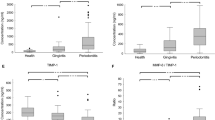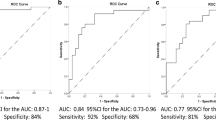Abstract
Salivary biomarker discovery requires identification of analytes with high discriminatory capacity to distinguish disease from health, including day-to-day variations that occur in analyte levels. In this study, seven biomarkers associated with inflammatory and tissue destructive processes of periodontal disease were investigated. In a prospective cohort study design, analyte expression levels were determined in unstimulated whole saliva samples collected on multiple occasions from 30 healthy adults (i.e., orally and systemically) and 50 chronic adult periodontitis patients. Salivary levels of IL-1β, IL-6, MMP-8, and albumin were significantly elevated (5.4 to 12.6X) and levels of IFNα were consistently lower (8.7X) in periodontitis patients compared with the daily variation observed in healthy adults. ROC analyses of IL-1β, IL-6 and MMP-8 yielded areas under the curves of 0.963-0.984 for discriminating periodontitis from health. These results demonstrate that levels of salivary bioanalytes of patients who have periodontitis are uniquely different from normal levels found in healthy subjects, and a panel consisting of IL-1β, MMP-8 and IL-6 shows particular diagnostic potential.




Similar content being viewed by others
References
Demmer RT, Papapanou PN. Epidemiologic patterns of chronic and aggressive periodontitis. Periodontol 2000. 2010;53:28–44.
Cobb CM, Williams KB, Gerkovitch MM. Is the prevalence of periodontitis in the USA in decline? Periodontol 2000. 2009;50:13–24.
Kinane D, Bouchard P. Periodontal diseases and health: consensus report of the Sixth European Workshop on Periodontology. J Clin Periodontol. 2008;35(8 Suppl):333–7.
Seymour GJ, Ford PJ, Cullinan MP, Leishman S, Yamazaki K. Relationship between periodontal infections and systemic disease. Clin Microbiol Infect. 2007;13 Suppl 4:3–10.
Paquette DW. Periodontal disease and the risk for adverse pregnancy outcomes. Grand Rounds in Oral-Systemic Medicine. 2006;1(4):14–24.
Offenbacher S, Beck JD, Moss K, Mendoza L, Paquette DW, Barrow DA, et al. Results from the Periodontitis and Vascular Events (PAVE) Study: a pilot multicentered, randomized, controlled trial to study effects of periodontal therapy in a secondary prevention model of cardiovascular disease. J Periodontol. 2009;80(2):190–201.
Noble JM, Borrell LN, Papapanou PN, Elkind MS, Scarmeas N, Wright CB. Periodontitis is associated with cognitive impairment among older adults: analysis of NHANES-III. J Neurol Neurosurg Psychiatry. 2009;80(11):1206–11.
Novak KF, Taylor GW, Dawson DR, Ferguson 2nd JE, Novak MJ. Periodontitis and gestational diabetes mellitus: exploring the link in NHANES III. J Public Health Dent. 2006;66(3):163–8.
Jimenez M, Krall EA, Garcia RI, Vokonas PS, Dietrich T. Periodontitis and incidence of cerebrovascular disease in men. Ann Neurol. 2009;66(4):505–12.
Demmer RT, Kocher T, Schwahn C, Volzke H, Jacobs Jr DR, Desvarieux M. Refining exposure definitions for studies of periodontal disease and systemic disease associations. Community Dent Oral Epidemiol. 2008;36(6):493–502.
Jin LJ, Armitage GC, Klinge B, Lang NP, Tonetti M, Williams RC. Global oral health inequalities: task group–periodontal disease. Adv Dent Res. 2011;23(2):221–6.
Beaglehole R, Benzian H, Crail J, Mackay J. The Oral Health Atlas. Mapping a neglected global health issue. FDI World Dental Foundation. 2009;http://www.oralhealthatlas.org/Read.html.
Williams DM. Global oral health inequalities: the research agenda. Adv Dent Res. [Editorial Introductory]. 2011;23(2):198–200.
Casamassimo PS, Thikkurissy S, Edelstein BL, Maiorini E. Beyond the dmft: the human and economic cost of early childhood caries. Journal of the American Dental Association. [Review]. 2009;140(6):650–7.
Centers for Medicare & Medicaid Services. http://wwwcmsgov/NationalHealthExpendData/downloads/tablespdf. 2009.
Ghiabi E, Weerasinghe S. The periodontal examination profile of general dentists in Nova Scotia, Canada. Journal of periodontology. [Research Support, Non-U.S. Gov't]. 2011;82(1):33–40.
Zhang L, Xiao H, Wong DT. Salivary biomarkers for clinical applications. Mol Diagn Ther. 2009;13(4):245–59.
Giannobile WV, Beikler T, Kinney JS, Ramseier CA, Morelli T, Wong DT. Saliva as a diagnostic tool for periodontal disease: current state and future directions. Periodontol 2000. 2009;50:52–64.
Teles RP, Likhari V, Socransky SS, Haffajee AD. Salivary cytokine levels in subjects with chronic periodontitis and in periodontally healthy individuals: a cross-sectional study. J Periodontal Res. 2009;44(3):411–7.
Miller CS, Foley JD, Bailey AL, Campell CL, Humphries RL, Christodoulides N, et al. Current developments in salivary diagnostics. Biomark Med. 2010;4(1):171–89.
Kinney JS, Morelli T, Braun T, Ramseier CA, Herr AE, Sugai JV, et al. Saliva/pathogen biomarker signatures and periodontal disease progression. Journal of dental research. [Clinical Trial Research Support, N.I.H., Extramural Research Support, Non-U.S. Gov't]. 2011;90(6):752–8.
Thomas MV, Branscum A, Miller CS, Ebersole J, Al-Sabbagh M, Schuster JL. Within-subject variability in repeated measures of salivary analytes in healthy adults. J Periodontol. 2009;80(7):1146–53.
Biyikoglu B, Buduneli N, Kardesler L, Aksu K, Oder G, Kutukculer N. Evaluation of t-PA, PAI-2, IL-1beta and PGE(2) in gingival crevicular fluid of rheumatoid arthritis patients with periodontal disease. J Clin Periodontol. 2006;33(9):605–11.
Armitage GC. Periodontal diagnoses and classification of periodontal diseases. Periodontol 2000. [Review]. 2004;34:9–21.
Michalowicz BS, Hodges JS, DiAngelis AJ, Lupo VR, Novak MJ, Ferguson JE, et al. Treatment of periodontal disease and the risk of preterm birth. N Engl J Med. 2006;355(18):1885–94.
Navazesh M. Methods for collecting saliva. Ann N Y Acad Sci. 1993;694:72–7.
Brown LF, Fraser CG. Assay validation and biological variation of serum receptor for advanced glycation end-products. Ann Clin Biochem. 2008;45(Pt 5):518–9.
Lacher DA, Hughes JP, Carroll MD. Biological variation of laboratory analytes based on the 1999–2002 National Health and Nutrition Examination Survey. Natl Health Stat Report. 2010;(21):1–7.
Siest G. Study of reference values and biological variation: a necessity and a model for Preventive Medicine Centers. Clin Chem Lab Med. 2004;42(7):810–6.
Williams GZ, Widdowson GM, Penton J. Individual character of variation in time-series studies of healthy people: II. Differences in values for clinical chemical analytes in serum among demographic groups, by age and sex. Clin Chem. 1978;24(2):313–20.
Chiappin S, Antonelli G, Gatti R, De Palo EF. Saliva specimen: a new laboratory tool for diagnostic and basic investigation. Clin Chim Acta. 2007;383(1–2):30–40.
Niedbala RS, Feindt H, Kardos K, Vail T, Burton J, Bielska B, et al. Detection of analytes by immunoassay using up-converting phosphor technology. Anal Biochem. 2001;293(1):22–30.
Frodge BD, Ebersole JL, Kryscio RJ, Thomas MV, Miller CS. Bone remodeling biomarkers of periodontal disease in saliva. J Periodontol. 2008;79(10):1913–9.
Miller CS, King Jr CP, Langub MC, Kryscio RJ, Thomas MV. Salivary biomarkers of existing periodontal disease: a cross-sectional study. J Am Dent Assoc. 2006;137(3):322–9.
Scannapieco FA, Ng P, Hovey K, Hausmann E, Hutson A, Wactawski-Wende J. Salivary biomarkers associated with alveolar bone loss. Ann N Y Acad Sci. 2007;1098:496–7.
Kinney JS, Ramseier CA, Giannobile WV. Oral fluid-based biomarkers of alveolar bone loss in periodontitis. Ann N Y Acad Sci. 2007;1098:230–51.
Taba M, Jr., Kinney J, Kim AS, Giannobile WV. Diagnostic biomarkers for oral and periodontal diseases. Dent Clin North Am. 2005;49(3):551–71, vi.
Taubman MA, Kawai T, Han X. The new concept of periodontal disease pathogenesis requires new and novel therapeutic strategies. J Clin Periodontol. 2007;34(5):367–9.
Kinane DF, Bartold PM. Clinical relevance of the host responses of periodontitis. Periodontol 2000. 2007;43:278–93.
Tatakis DN, Kumar PS. Etiology and pathogenesis of periodontal diseases. Dent Clin North Am. 2005;49(3):491–516, v.
Acknowledgements
We thank Hailey Wilson, manager of the Delta Dental of Kentucky Clinical Research Center, and clinical coordinators, Dawn Dawson, Vanessa Hodges, and Brittany Fuller for their expert services in managing the patients and samples.
Research Funding
This study was supported by grant U01 DE017793, from the NIH/NIDCR, P20 RR020145 from the NIH/NCRR, and funds from the Center for Oral Health Research in the University of Kentucky College of Dentistry. The authors state no conflict of interest related to this study.
Author information
Authors and Affiliations
Corresponding author
Additional information
Author Contributions
All authors have contributed to the intellectual content of this paper and meet the following 3 requirements: (a) significant contributions to the conception and design, acquisition of data, or analysis and interpretation of data; (b) drafting or revising the article for intellectual content; and (c) final approval of the published article.
Rights and permissions
About this article
Cite this article
Ebersole, J.L., Schuster, J.L., Stevens, J. et al. Patterns of Salivary Analytes Provide Diagnostic Capacity for Distinguishing Chronic Adult Periodontitis from Health. J Clin Immunol 33, 271–279 (2013). https://doi.org/10.1007/s10875-012-9771-3
Received:
Accepted:
Published:
Issue Date:
DOI: https://doi.org/10.1007/s10875-012-9771-3




